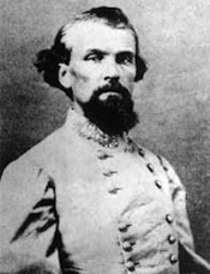
Few Union soldiers in the strategic depot of Murfreesboro were stirring on Sunday morning, July 13, 1862, when Confederate Col. Nathan Bedford Forrest’s cavalry thundered into town.
After U.S. Brigadier General James Negley’s June 7-8, 1862, attacks on the Confederates at Chattanooga, U.S. Major General Don Carlos Buell moved his Army of the Ohio from Corinth, Mississippi, toward Chattanooga to reinforce Negley. The Confederate response was to divert the reinforcements and to draw Union troops away from Chattanooga. Confederate Colonel Nathan Bedford Forrest was dispatched from Chattanooga with two cavalry units to retake Murfreesboro. At that time, Murfreesboro, a strategic supply depot on the Nashville and Chattanooga Railroad, was held by a small Union force camped in and around the town.
Forrest, with a troop count of about 1,400, attacked the uncoordinated Union emplacements on July 13 and captured between 800 and 1,200 prisoners as well as a large cache of supplies all amounting to about a quarter of a million dollars. The greatest damage was the destruction to the railroad; the depot, a substantial length of tracks, and the bridge south of town were torn up or burned. Confederate casualties numbered 150, mostly from sharpshooters in the cupola of the courthouse. Owing to the large number of prisoners taken, Forrest had to retreat to McMinnville, leaving Murfreesboro open again to Federal occupation.
The raid was the first significant operation behind Federal lines in the western theater. As Forrest’s first independent raid, its success catapulted Forrest to great renown and a promotion to brigadier general. The raid succeeded in diverting Union regiments from reinforcing Negley’s troops at Chattanooga and disrupted Union control of Middle Tennessee by destroying communications and stores at Murfreesboro. Because the Union officers mistakenly estimated that Forrest had as many as 3,500 troops, local garrisons were called in from the Army of the Ohio to protect Nashville and Middle Tennessee. This allowed Confederate General Braxton Bragg to concentrate his forces for an August campaign into Kentucky, ultimately leading to the Battle of Perryville in October.
Tools
Key Facts
- A substantial Federal garrison, divided into three emplacements, guarded the vital Nashville and Chattanooga Railroad line.
- Forrest successfully attacked all three, cementing his reputation for brilliance.




